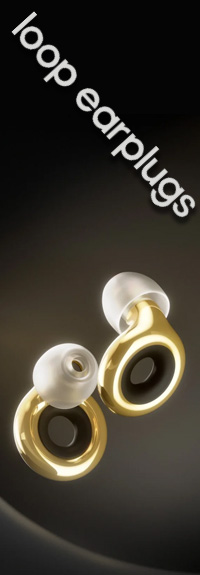A Polivoks? Ever hear of that?
No.
Me neither. Supposedly a classic analog synth from Russia.
Okay.
Erica Synths has packaged an emulation of the Polivoks Voltage Controlled Filter in something they're calling an Acidbox.
Who?
Erica Synths.
Where are they out of?
Latvia.
Latvia?
Yes.
I'm guessing we're going to review the Acidbox?
No, not the Acidbox, the AcidboxII.
The sequel?
A mark 2.
Okay, so this is a tweak box?
Something like that.
Long-term test?
Yes.
And I'm getting it first?
Yes. So you better find out what a Polivoks is...
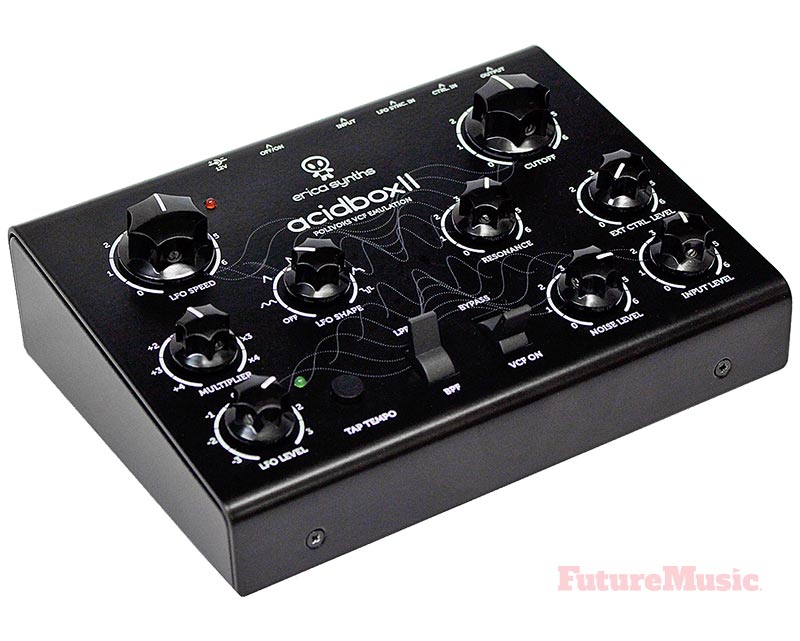
Erica Synths is a new boutique synth manufacturer out of Latvia. Driven by “a team of creative visionaries, musicians and genius engineers,” the outfit is definitely rebel, despite the cute panda logo. Since they delivered their AcidboxII, they’ve been on quite a tear releasing several Eurorack analog components, which as you know, is all the rage right now. The AcidboxII is a standalone desktop unit built like a tank and features those old-school Torx knobs in three different sizes that scream “Tweak Me!” The LFO Speed and Cutoff are the papa bears; LFO Shape and Resonance are the mama bears; and the LFO Level, Noise Level, Input Level, External Control Level and Multiplier are the baby bears of the knobs. There are two toggles, BPF/LPF and VCF On/Bypass, as well as a tap tempo button, which round out all the controls. On the rear there is a On/Off toggle, a 1/4” Input, LFO Sync In, Control In and a mono Output. If you want an LFO output, it’s 20 euros more.

Before we get into more specifics, let’s talk Polivoks. The duophonic analog synth was produced by Formanta Electronics in the early 1980’s and solely distributed in the USSR. The synth featured two oscillators with triangle, saw, to pulse wave variations and a noise generator. It was known for producing zippery bass and setting fire to tweeters with the ability to create horrid, screeching noise, despite unstable oscillators, which had difficulty staying in tune. The Polivoks’ Jedi Power was its switchable dual-mode band pass / low pass filter. For
its day, this was a fascinating and somewhat questionable choice by Vladimir Kuzmin, the synth’s designer, who dismissed how the American synth manufacturers relied on capacitors for filter operation. Kuzmin also selected a 12dB/octave methodology with just two op-amp ICs and six resistors as opposed to the 24dB/octave filters in the wildly popular Minimoog. The result was a visceral, biting and distorted sound, which is what Erica targeted when creating their emulation. During our long-term test, our six reviewers had a lot to say about its
capabilities (their impressions in quotes below).
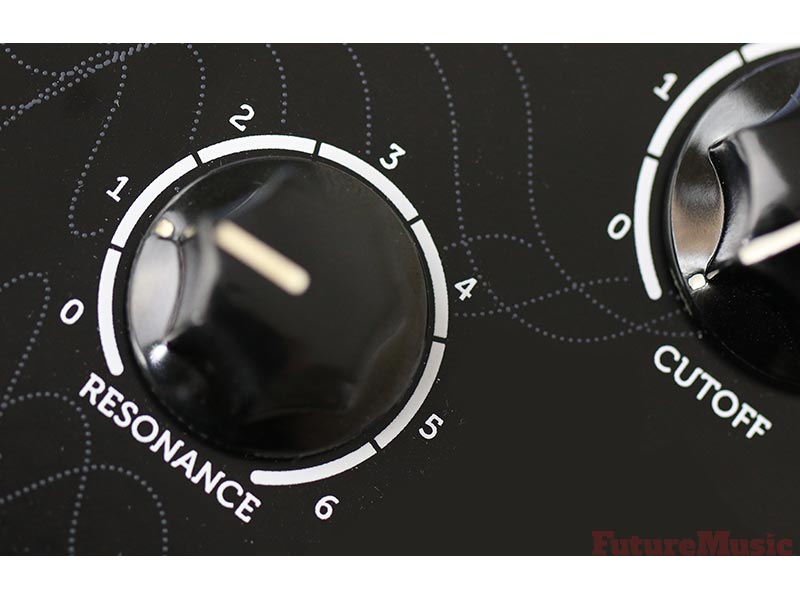
Erica Synth AcidboxII Features:
» Voltage Controlled Filter inspired by Polivoks VCF architecture
» Integrated circuits used in the original Polivoks
» Divide and multiply LFO frequency
» Analog white noise generator
» Internal LFO – Six waveforms and inverted waveforms
» Audio rate modulation
» TAP tempo
» External sync for LFO frequency
» Tap tempo and LFO output indication LEDs
» Balanced output
» Universal power supply included
While the AcidboxII appears to be a simple device, there is quite a lot going on under the hood and it’s obvious a lot of thought went into the unit by the designers. For the second incarnation, Erica redesigned the LFO with audio rate modulation enhancements, as well as the new waveforms. They also added a true-analog, white-noise generator allowing the AcidboxII to be used without an input signal. A balanced output was also added. MIDI is absent, but you can send a sharp signal, such as the rimshot from a drum machine into the LFO Sync Input on the rear to match your song tempo. In fact, the AcidboxII has “several interesting rhythmic features that are great for adding energy to synth sounds,” reported one evaluator. The most obvious rhythmic component is the Multiplier knob on the left, which allows you to Multiply or Divide the LFO Frequency by a factor of x2, x3 and x4, “providing a wealth of rhythmic possibilities at the twist of a knob.”
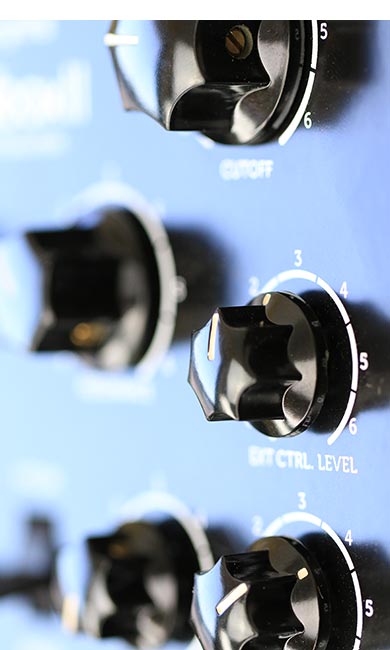
If you hold down the Tap Tempo button for four seconds, a hidden feature, it blitzes the unit by doubling the LFO rate (holding it down for another four seconds returns it to normal operation). Being a sonic adventurer is part of what makes the AcidboxII such an intriguing proposition. “Even though the [AcidboxII] does not have MIDI,” commented one reviewer, “there are many possibilities available in terms of tempo and LFO rate…it opens up realms of exploration that I would not have bothered to consider if I could just sync it to my gear via MIDI.”
Even though the unit only has a handful of controls, it can get a tad confusing. For example, the two toggle switches are somewhat counter-intuitive. Selecting LPF actually turns the BPF on and selecting BPF turns the LPF on. Same goes for the VCF On. Selecting Bypass turns it on and selecting VCF On turns it off. Definitely befuddling. However, “once you start using the AcidboxII and develop an understanding of its controls, the fun really begins.”
“Wait ‘Til The Chemical Bros. Get Their Hands On This!”
“Hands-on control is what the AcidboxII is all about,” determined one evaluator and Erica certainly designed the box to be played. With “beefy knobs” that “beautifully rotate with a silky feel,” you can create a sequence and then “get to work” by playing along with the AcidboxII. In fact, one of our testers took the AcidboxII out on stage to provide “additional sonic mayhem” to his Arturia MicroBrute. “The [MicroBrute] already has an edgy sound, which I take full advantage of, but adding the Acidbox to the signal chain, not only dialed the sound to 11, but allowed me to really ratchet my builds to entirely new levels.” Although, one of our testers “wished the AcidboxII had a stereo output” so she could add it to her DJ rig.
Erica Synths AcidboxII Technical Specifications:
» Input signal level: 20V ptp
» External CV level: 20V ptp
» LFO frequency: 0.1Hz – 60Hz
» Audio modulation frequency: 20Hz – 620Hz
» Universal Power supply: 110 – 220 V
» Weight: 0.7 kg
» Dimensions: 185mm x 140mm x 55mm
Breath New Life Into Your Hardware
With the acid sound now very much in the sonic consciousness of electronic music makers thanks to Roland’s recent TB-03 announcement. Adding some “acid flavor” to your current arsenal of hardware synths (or even to the TB-03! –Ed.) is now possible at the AcidboxII’s very attractive price point. Whether or not your are familiar with the Polivoks, is of little consequence. If you’re looking to “add sonic mayhem” to your sound or just looking to breath new life into your older synths, you can’t go wrong with the Erica Synths AcidboxII. Highly Recommended.
Rating: 96%
Cheers:
+ Build Quality
+ Sound quality
+ Flexibility
+ Playability
+ Bang for the buck
+ Innovative
Jeers:
– Counterintuitive toggle switches
– No MIDI
Erica Synth’s AcidboxII costs €250 and is available now.
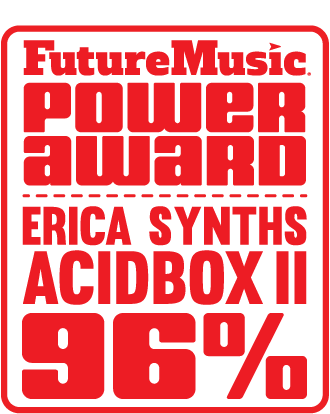
The Future:
Although the LFO Input, Tap Tempo and Multiplier adds a distinctively analog tempo solution, we’d like to see the addition of full MIDI, not just for Sync, but for automating the modulators. A stereo version, with the ability to Link, would also add a whole new dimension to the Acidbox’s possibilities, especially for live performance and DJing.
Other Impressions:
Ask Audio: 4.5 Stars (out of 5)




